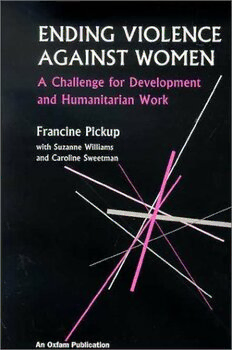
Ending Violence Against Women: A Challenge for Development and Humanitarian Work (Oxfam Development Guidelines) PDF
387 Pages·2001·1.434 MB·English
Most books are stored in the elastic cloud where traffic is expensive. For this reason, we have a limit on daily download.
Preview Ending Violence Against Women: A Challenge for Development and Humanitarian Work (Oxfam Development Guidelines)
Description:
Violence, and women's fear of it, limits women's choices in virtually all spheres of their lives. It has long-term, as well as short-term, consequences on women's physical and emotional well-being. It detrimentally affects women's ability to gain an education, earn a livelihood, develop human relationships, and participate in public activities, including development programs. Yet development organizations have been generally slow to realize the centrality of the issue to their work. By addressing violence against women, development workers go to the heart of how members of communities relate to one another and how they are able to shape their own lives.The first section of the book examines the many different definitions of violence against women, and offers theories about why it happens in all societies across the world. It discusses the current momentum around the issue, and asks why development organizations have been slow to take up the struggle to end violence against women. The second section focuses on strategies to counter violence against women and support the survivors. Case studies come from times of peace and times of armed conflict. Sections suggest strategies for transforming attitudes and beliefs in different societies that condone such violence; for supporting individual survivors; and to ensure that governments and NGOs fulfill their duty to protect women.
See more
The list of books you might like
Most books are stored in the elastic cloud where traffic is expensive. For this reason, we have a limit on daily download.
